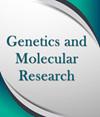研究文章:中美洲普通豆基因型杂交根分布的遗传结构
IF 0.2
Q4 GENETICS & HEREDITY
引用次数: 0
摘要
对一个性状的遗传结构的了解决定了整个育种计划的策略。本研究的目的是确定影响普通豆根遗传控制的加性和非加性效应。在2018/19生长季进行了75个处理的部分平衡不完全块设计的田间试验。采用三试杂交设计的回交后代(L1 P1 × F2, L2 P2 × F2和L3 F1 × F2),以中美洲亲本P1- baf50(活跃种质库的加入)和P2- ipr Uirapuru(商品品种)为亲本。采用原位土壤开挖法对性状根系分布进行了评价。为此,在每株植物下开辟沟渠(每个处理每个复制两株植物),并在开放的剖面上插入网格。对沟槽内的栅格进行拍照,以此定量评估根系分布(百分比)。为了比较根和茎的生物量,在收获时计算豆荚和籽粒的数量。通过建立预测函数,将处理因子划分为遗传效应(加性、显性和上位性)。加性遗传效应最大本文章由计算机程序翻译,如有差异,请以英文原文为准。
Research Article Genetic structure of root distribution in genotype crosses of Mesoamerican common bean
Knowledge of the genetic structure of a trait shapes the entire strategy of a breeding program. In this study, the purpose was to determine the additive and non-additive effects that affect the genetic control of common bean roots. A field experiment, with 75 treatments in a partially balanced incomplete block design, was carried out in the 2018/19 growing season. The treatments consisted of backcross progenies (L1 P1 x F2, L2 P2 x F2 and L3 F1 x F2) resulting from a Triple Test Cross mating design, with the Mesoamerican parents P1-BAF50 (accession of the active germplasm bank) and P2-IPR Uirapuru (commercial cultivar). The trait root distribution was assessed based on the soil excavation method, in situ. To this end, trenches were opened under each plant (two plants per replication, in each treatment) and a grid was inserted in the open profile. Pictures were taken of the grid in the trench, based on which the root distribution (percentage) could be quantitatively assessed. To compare root and shoot biomass, the numbers of pods and grains were counted at harvest. The treatment factor was partitioned into genetic effects (additive, dominant and epistatic) by the establishment of predictive functions. The additive genetic effect was the most
求助全文
通过发布文献求助,成功后即可免费获取论文全文。
去求助
来源期刊

Genetics and Molecular Research
生物-生化与分子生物学
CiteScore
1.00
自引率
25.00%
发文量
7
审稿时长
3 months
期刊介绍:
Genetics and Molecular Research (GMR), maintained by the Research Foundation of Ribeirão Preto (Fundação de Pesquisas Científicas de Ribeirão Preto), publishes high quality research in genetics and molecular biology. GMR reflects the full breadth and interdisciplinary nature of this research by publishing outstanding original contributions in all areas of biology.
GMR publishes human studies, as well as research on model organisms—from mice and flies, to plants and bacteria. Our emphasis is on studies of broad interest that provide significant insight into a biological process or processes. Topics include, but are not limited to gene discovery and function, population genetics, evolution, genome projects, comparative and functional genomics, molecular analysis of simple and complex genetic traits, cancer genetics, medical genetics, disease biology, agricultural genomics, developmental genetics, regulatory variation in gene expression, pharmacological genomics, evolution, gene expression, chromosome biology, and epigenetics.
 求助内容:
求助内容: 应助结果提醒方式:
应助结果提醒方式:


